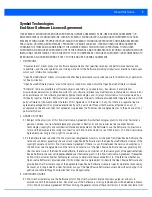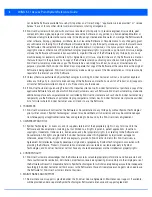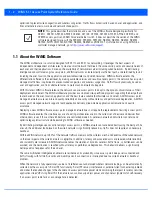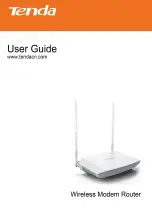
1 - 2
WiNG 5.7.1 Access Point System Reference Guide
optimized to prevent wired congestion and wireless congestion. Traffic flows dynamically, based on user and application, and
finds alternate routes to work around network choke points.
1.1 About the WiNG Software
The WiNG architecture is a solution designed for 802.11n and 802.11ac networking. It leverages the best aspects of
independent and dependent architectures to create a smart network that meets the connectivity, quality and security needs of
each user and their applications, based on the availability of network resources including wired networks. By distributing
intelligence and control amongst access points, a WiNG network can route directly via the best path, as determined by factors
including the user, location, the application and available wireless and wired resources. WiNG software extends the
differentiation offered to the next level, by making available services and security at every point in the network. Access point
managed traffic flow is optimized to prevent wired congestion and wireless congestion. Traffic flows dynamically, based on
user and application, and finds alternate routes to work around network choke points.
With this latest WiNG software release, the network can use access points to adapt to the dynamic circumstances of their
deployment environment. The WiNG architecture provides a customized site-specific deployment, supporting the best path and
routes based on the user, location, application and the best route available (both wireless and wired). A WiNG access point
managed network assures end-to-end quality, reliability and security without latency and performance degradation. A WiNG
access point managed network supports rapid application delivery, mixed-media application optimization and quality
assurance.
Deploying a new WiNG software access point managed network does not require the replacement of existing access points.
WiNG software enables the simultaneous use of existing architectures used in the current set of devices and devices from
other vendors, even if those other architectures are centralized models. A wireless network administrator can retain and
optimize legacy infrastructure while evolving to WiNG software as needed.
By distributing intelligence and control amongst access points, a WiNG network can route data directly using the best path. As
a result, the additional load placed on the wired network is significantly reduced, as traffic does not require an unnecessary
backhaul.
Within a WiNG network, up to 80% of the network traffic can remain on the wireless mesh, and never touch the wired network,
so the load impact on the wired network is negligible. In addition, latency and associated costs are reduced while reliability
and scalability are increased. A WiNG network enables the creation of dynamic wireless traffic flows, so bottlenecks can be
avoided, and the destination is reached without latency or performance degradation. This behavior delivers a significantly
better quality of experience for the end user.
The same distributed intelligence enables more resilience and survivability, since access points keep users connected and
traffic flowing with full QoS, security and mobility even if a connection is interrupted due to a wired network or backhaul
problem.
When the network is fully operational, sources of interference or unbalanced wireless network loading can be automatically
corrected by the access point’s Smart RF functionality. Smart RF senses interference or potential client connectivity problems
and makes the required changes to the channel and access point radio power while minimizing the impact to latency sensitive
applications like VoIP. Using Smart RF, the network can continuously adjust power and channel assignments for self-recovery
if an access point radio fails or a coverage hole is detected.
NOTE:
This guide describes the installation and use of the WiNG software designed specifically for
AP6511, AP6521, AP6522, AP6532, AP6562, AP71XX, AP7502, AP7522, AP7532, AP7562, AP81XX and
AP82XX access points and ES6510 model ethernet switch. It does not describe the version of the WiNG
software designed for use with the RFS4000, RFS6000, RFS7000, NX4500, NX4524, NX6500, NX6524,
NX7500, NX7510,NX7520, NX7530, NX9000, NX9500 and NX9510. For information on using WiNG in a
controller managed network, go to
.
Summary of Contents for WiNG 5.7.1
Page 1: ...WiNG 5 7 1 ACCESS POINT SYSTEM REFERENCE GUIDE ...
Page 2: ......
Page 3: ...WING 5 7 1 ACCESS POINT SYSTEM REFERENCE GUIDE MN001977A01 Revision A April 2015 ...
Page 4: ...ii WiNG 5 7 1 Access Point System Reference Guide ...
Page 24: ...1 4 WiNG 5 7 1 Access Point System Reference Guide ...
Page 36: ...2 12 WiNG 5 7 1 Access Point System Reference Guide ...
Page 72: ...3 36 WiNG 5 7 1 Access Point System Reference Guide ...
Page 470: ...5 386 WiNG 5 7 1 Access Point System Reference Guide ...
Page 472: ...6 2 WiNG 5 7 1 Access Point System Reference Guide Figure 6 1 Configuration Wireless menu ...
Page 624: ...7 46 WiNG 5 7 1 Access Point System Reference Guide ...
Page 724: ...9 56 WiNG 5 7 1 Access Point System Reference Guide ...
Page 783: ...12 35 Figure 12 46 Device Summary screen 4 Click File Management ...
Page 816: ...12 68 WiNG 5 7 1 Access Point System Reference Guide ...
Page 1006: ...13 190 WiNG 5 7 1 Access Point System Reference Guide ...
Page 1026: ...14 20 WiNG 5 7 1 Access Point System Reference Guide ...
Page 1028: ...A 2 WiNG 5 7 1 Access Point System Reference Guide ...
Page 1089: ......
Page 1090: ...MN001977A01 Revision A April 2015 ...
















































